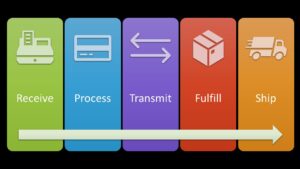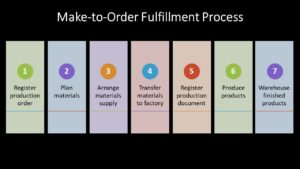How to Perfect Your Order Management Workflow
How efficient is your company’s order management workflow? No matter how good you think you are at order management, you can always get better. You can do several things to perfect your order workflow, including employing an order management system, such as Salesforce Order Management.
Understanding Order Workflow
Order management workflow describes everything that happens between a customer placing an order and that order being shipped to the customer. Every type of commerce follows a similar workflow that includes the following general steps:
- Receipt: Order received from the customer
- Process: Customer payment processed, typically by a third-party payment processor
- Transmit: Order details transmitted to the distribution center, accounting, and other appropriate departments
- Fulfill: Order picked and packed
- Ship: Package is scheduled for shipment from your warehouse or appropriate shipping service
Why Order Management Workflow is Important
The effectiveness and efficiency of your real-time order management workflow determine both the speed and accuracy of your order fulfillment. If you’re too slow or have too many packing or shipping errors, your customers will abandon you for competitors with better order workflows. According to Flexe’s The Omnichannel Retail Report, 62% of online shoppers say delivery speed influences their purchasing decisions – and 85% say they’ll shop elsewhere to get faster shipping. A report by Coveo Research reveals that 73% of customers will abandon a brand after three or fewer negative experiences.
In short, it’s in your own best business interests to perfect your order management workflow – and retain your hard-earned customer base.
How to Improve Order Management Workflow
There are several things you can do to improve the efficiency and accuracy of your order management workflow. Let’s look at each step of the order workflow separately.
Improving Order Receipt
Whether you’re selling via B2C ecommerce or B2B direct sales, improving the efficiency of the customer ordering process is paramount. Focus on the following issues:
- For ecommerce orders, ensure sufficient website speed
- For B2B or direct sales orders, automate the sales process (including lead management)
- Centralize all order intake
- Integrate order intake with other key systems (payment processing, order processing, fulfillment, etc.)
Improving Payment Processing
Payment processing should be seamless and transparent to the customer yet accurate and secure for your business. To improve the payment process, focus on these issues:
- Provide a seamless real-time payment gateway on your website
- Integrate anti-fraud tools into your payment processing
- Integrate payment processing with other key systems
Improving Order Transmittal
Order transmittal is a key part of the order workflow process. Focus on these issues:
- Identify all departments that need to receive order data
- Integrate order management process with key systems in all appropriate departments
- Provide real-time data transfer
Improving Order Fulfillment
The order fulfillment process is specific to each type of business. For a B2C business, it’s a relatively simple matter of picking the product from the warehouse shelves, noting any out-of-stock products that need to be back-ordered; and packing the entire order. The fulfillment process is even more complex if you’re a manufacturer with a make-to-order model because you have to make sure you have the right raw materials on hand, schedule production time, and move the finished product into your warehouse.
Whatever type of business you run, you can focus on the following fulfillment issues to improve your order management workflow:
- Employ an automated inventory management system
- Automate as much of the picking process as possible
- Organize your warehouse with best-selling items nearest packing stations
- Ensure adequate supply of packaging materials
- Verify contents of each package as it’s being packed
Improving Shipping
Shipping follows directly from the picking/packing process. Some companies deliver their own shipments; others contract with a shipping carrier such as FedEx, UPS, or the USPS. Focus on these issues to improve your shipping process:
- Use integrated systems to prepare the shipping department
- Integrate shipping labels and postage into your fulfillment system
- Automatically notify customers when orders ship
- Employ shipment tracking – and communicate tracking info to customers
How an Order Management System Can Improve Your Order Workflow
Employing an order management system provides the most immediate and long-term impact of everything you can do to perfect your order management workflow. A digital order management system, such as Salesforce Order Management, automates and monitors all phases of the order workflow, from initial order intake through the final product shipment. An order management system also integrates with all of your critical systems and departments, so the necessary information is automatically transmitted in real-time.
The following video demonstrates how Salesforce Order Management works.
Order Receipt
As soon as the customer places an order (or a salesperson enters the order into the system), that order is automatically transmitted to your inventory management system. Items ordered are compared to your current in stock, and the customer is advised of whether the item is available and its projected shipping time.
Payment Processing
The payment data is automatically sent to your designated payment processor as soon as the customer submits payment. When the payment is approved, the order is finalized, and information about the order is sent to your accounting department.
Order Transmittal
Because the order management system is tightly integrated with your other essential systems, every department is automatically notified that the order has been placed and approved. Order data is sent to your distribution center, production (for manufacturing businesses), and accounting. If this is a direct sale, the sales department is also notified.
Fulfillment
As soon as your distribution center receives the order, the items purchased are pulled from inventory. If you utilize a make-to-order manufacturing model, the necessary materials are pulled or ordered, and production is scheduled. Inventory is constantly evaluated and reordered as necessary. Items ready for shipping are properly packaged with items from multiple orders combined into a single shipment if possible.
Shipping
Shipping labels are automatically generated when the items are pulled from inventory. The labeled package is either readied for delivery or turned over to your authorized shipping service. The customer is automatically notified of the shipment, typically by email, and provided with a tracking number.
Let Rainmaker Help You Perfect Your Order Management Workflow
Salesforce Order Management is an essential tool for improving your company’s order management workflow. Turn to the Salesforce experts at Rainmaker to implement and integrate Salesforce into your sales and fulfillment operations – and improve your order efficiency and accuracy.
Contact Rainmaker today to learn more about using Salesforce Order Management in your business!








